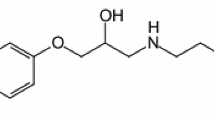Abstract
The thermal behavior of several LiPF6 solutions was studied using a C80 calorimeter. It was found that oxygen might react with the solvents and decrease their thermal stability. The dissolution of LiPF6 influences the thermal behavior remarkably with more heat generation and a lower onset temperature. Furthermore, the exothermic peak of LiPF6 based on an electrolyte containing diethyl carbonate (DEC) was found around 185 ∘C, which is 9.5–13.6 ∘C lower than that containing dimethyl carbonate (DMC), which may be due to the relative activity of C2H5— and CH3— in DEC and DMC, respectively.
Similar content being viewed by others
References
Y. Baba, S. Okada, and J. Yamaki, Thermal Stability of Li x CoO2 Cathode for Lithium Ion Battery, Solid State Ionics 148, 311–316 (2002).
J. Yamaki, Y. Baba, N. Katayama, H. Takatsuji, M. Egashira, and S. Okada, Thermal Stability of Electrolytes with Li x CoO2 Cathode or Lithiated Carbon Anode, J. Power Sources 119–121, 789–793 (2003).
J. Jiang and J. R. Dahn, Effects of Particle Size and Electrolyte Salt on the Thermal Stability of Li0.5CoO2, Electrochim. Acta 49, 2661–2666 (2004).
J. Jiang and J. R. Dahn, Effects of Solvents and Salts on the Thermal Stability of LiC6, Electrochim. Acta 49, 4599–4604 (2004).
G. G. Botte, R. E. White, and Z. Zhang, Thermal Stability of LiPF6–EC:EMC Electrolyte for Lithium Ion Batteries, J. Power Sources 97–98, 570–575 (2001).
T. Kawamura, A. Kimura, M. Egashira, S. Okada, and J. Yamaki, Thermal Stability of Alkyl Carbonate Mixed-solvent Electrolytes for Lithium Ion Cells, J. Power Sourc. 104, 260–264 (2002).
J. S. Gnanaraj, E. Zinigrad, L. Asraf, H. E. Gottlieb, M. Sprecher, M. Schmidt, W. Geissler, and D. Aurbach, A Detailed Investigation of the Thermal Reactions of LiPF6 Solution in Organic Carbonates using ARC and DSC, J. Electrochem. Soc. 150, A1533–A1537 (2003).
D. D. MacNeil and J. R. Dahn, Can an Electrolyte for Lithium-ion Batteries be too Stable? J. Electrochem. Soc. 150, A21–A28 (2003).
H. Maleki, G. Deng, A. Anani, and J. Howard, Thermal Stability Studies of Li-ion Cells and Components, J. Electrochem. Soc. 146, 3224–3229 (1999).
J. H. Sun, X. Li, K. Hasegawa, and G. Liao, Thermal Hazard Evaluation of Complex Reactive Substance Using Calorimeters and Dewar Vessel, J. Therm. Anal. Cal. 76, 883–893 (2004).
Q. S. Wang, J. H. Sun, X. L. Yao, and C. H. Chen, 4-Isopropyl Phenyl Diphenyl Phosphate as Flame-retardant Additive for Lithium-ion Battery Electrolyte, Electrochem. Solid-State Lett. 8, A467–A470 (2005).
J. H. Sun, Y. F. Li, and K. Hasegawa, A Study of Self-accelerating Decomposition Temperature (SADT) Using Reaction Calorimetry, J. Loss Prevent. Process Ind. 14, 331–336 (2001).
B. Ravdel, K. M. Abraham, R. Gitzendanner, J. DiCarlo, B. Lucht, and C. Campion, Thermal Stability of Lithium-ion Battery Electrolytes, J. Power Sources 119–121, 805–810 (2003).
K. Tasaki, K. Kanda, S. Nakamura, and M. Ue, Decomposition of LiPF6 and Stability of PF5 in Li-ion Battery Electrolytes, J. Electrochem. Soc. 150, A1628–A1636 (2003).
Q. S. Wang, J. H. Sun, X. L. Yao, and C. H. Chen, Thermal Stability of LiPF6/EC + DEC Electrolyte with Charged Electrodes for Lithium Ion Batteries, Thermochim. Acta 437(1C2), 12 C16 (2005).
S. E. Sloop, J. B. Kerr, and K. Kinoshita, The Role of Li-ion Battery Electrolyte Reactivity in Performance Decline and Self-discharge, J. Power Sources 119–121, 330–337 (2003).
J. S. Gnanaraj, E. Zinigrad, L. Asraf, H. E. Gottlieb, M. Sprecher, D. Aurbach, and M. Schmidt, The use of accelerating rate calorimetry (ARC) for the study of the thermal reactions of Li-ion battery electrolyte solutions, J. Power Sources 119–121, 794–798 (2003).
P. Tundo, New Developments in Dimethyl Carbonate Chemistry, Pure Appl. Chem. 73, 1117–1124, (2001).
D. Aurbach, A. Zaban, Y. Ein-Eli, I. Weissman, O. Chusid, B. Markovsky, M. Levi, E. Levi, A. Schechter, and E. Granot, Recent Studies on the Correlation Between Surface Chemistry, Morphology, Three-dimensional Structures and Performance of Li and Li-C Intercalation Anodes in Several Important Electrolyte Systems, J. Power Sources 68(1), 91–98 (1997).
Y. Ono, Dimethyl Carbonate for Environmentally Benign Reactions, Pure Appl. Chem. 68, 367–375 (1996).
Author information
Authors and Affiliations
Corresponding author
Rights and permissions
About this article
Cite this article
Wang, Q., Sun, J., Yao, X. et al. C80 Calorimeter Studies of the Thermal Behavior of LiPF 6 Solutions. J Solution Chem 35, 179–189 (2006). https://doi.org/10.1007/s10953-006-9377-6
Received:
Accepted:
Issue Date:
DOI: https://doi.org/10.1007/s10953-006-9377-6




